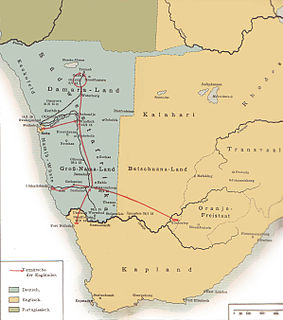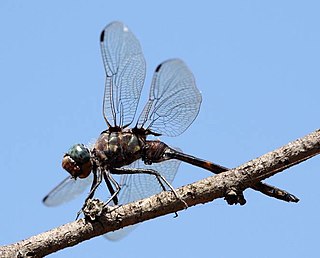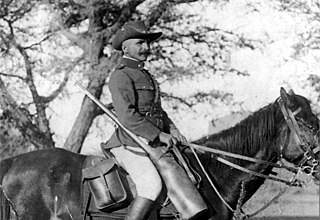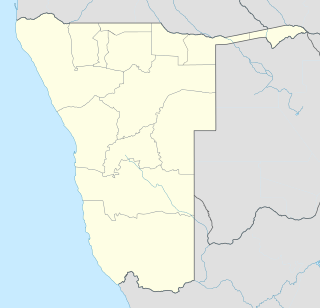
The South West Africa campaign was the conquest and occupation of German South West Africa by forces from the Union of South Africa acting on behalf of the British imperial government at the beginning of the First World War.

Sesfontein is a settlement in the Kunene Region of Namibia, situated 150 kilometres (93 mi) from the regional capital Opuwo. It is the district capital of Sesfontein Constituency, its population is 7,358. Sesfontein derives its name from the six fountains which have their source in the vicinity. The settlement features a clinic.

Action Christian National (ACN) was a white nationalist political party in Namibia. The ACN was established in 1989 to enable whites to participate in the elections. It used to be aligned with the National Party of South Africa. In the Namibian parliamentary election, 1989 that elected the members of the Constituent Assembly of Namibia, ACN won three seats. The party's chairman was Jan de Wet. It subsequently became the Monitor Action Group.
Kwanyama or Cuanhama is a national language of Angola and Namibia. It is a standardized dialect of the Ovambo language, and is mutually intelligible with Oshindonga, the other Ovambo dialect with a standard written form.

The Hoba meteorite, short for Hoba West, is a meteorite that lies on the farm of the same name, not far from Grootfontein, in the Otjozondjupa Region of Namibia. It has been uncovered but, because of its large mass, has never been moved from where it fell. The main mass is estimated at more than 60 tonnes. It is the largest known intact meteorite and about twice as massive as the largest fragment of either the Cape York meteorite's 31-tonne Ahnighito kept in Manhattan or the Campo del Cielo's 31-tonne Gancedo in Argentina. It is also the most massive naturally occurring piece of iron known on Earth's surface. The name "Hoba" comes from Khoekhoegowab word meaning "gift". Following donation to the government in 1987 a visitor centre was constructed with a circular stone access and seating area.

Naulila is a town and commune in the municipality of Ombadja, province of Cunene, Angola.

Twyfelfontein, officially known as ǀUi-ǁAis, is a site of ancient rock engravings in the Kunene Region of north-western Namibia. It consists of a spring in a valley flanked by the slopes of a sandstone table mountain that receives very little rainfall and has a wide range of diurnal temperatures.

Zygonoides is a genus of dragonflies in the family Libellulidae. There are large, spectacular species. Three species occur in continental Africa and one, F. lachesis, in Madagascar.
The Roman Catholic Archdiocese of Windhoek is the Metropolitan See for the Ecclesiastical province of Windhoek in Namibia. The predecessor to the current Archdiocese, the Prefecture Apostolic of Cimbebasia, was established in 1892 and the current archdiocese was fully erected in March 1994. The current archbishop is Liborius Ndumbukuti Nashenda.

The Battle of Sandfontein was fought between the Union of South Africa on behalf of the British Imperial Government and the German Empire on 26 September 1914 at Sandfontein, during the first stage of the South West Africa Campaign of World War I, and ended in a German victory.

Buitepos is a small settlement in the Omaheke Region in eastern Namibia. It is situated on the national road B6 which is part of the Trans-Kalahari Highway, and a border post between Namibia and Botswana. The proposed Trans-Kalahari Railway may pass through this place, too.

Tses is a village in the ǁKaras Region of southern Namibia with a population of approximately 1000; probably 1000 more live in the surrounding semi-desert farming hinterland. It is situated one kilometre off the main B1 highway from Windhoek to Noordoewer, opposite the turning to Berseba and the Brukkaros Mountain. Tses in Khoekhoegowab means 'place of daylight'.

ǀAi-ǀAis is a Namibian holiday resort with hot mineral springs in the bed of the Fish River. It is situated in Southern Namibia's ǁKaras Region at the base of the Great Karas Mountains, 128 kilometres (80 mi) west of Karasburg and 224 kilometres (139 mi) south-west of Keetmanshoop.

German South West Africa was a colony of the German Empire from 1884 until 1915, though Germany did not officially recognise its loss of this territory until the 1919 Treaty of Versailles. With a total area of 835,100 km², it was one and a half times the size of the mainland German Empire in Europe at the time. The colony had a population of around 2,600 Germans.

The battle of Kakamas took place in Kakamas, Northern Cape Province of South Africa on 4 February 1915. It was a skirmish for control of two river fords over the Orange River between contingents of a German invasion force and South African armed forces. The South Africans succeed in preventing the Germans gaining control of the fords and crossing the river.

Reverend Johann Heinrich Schmelen, born Johann Hinrich Schmelen was a German missionary and linguist who worked in South Africa and South-West Africa. Traveling through the area of today's northern South Africa and central and southern Namibia he founded the mission stations at Bethanie and Steinkopf and discovered the natural harbour at Walvis Bay. Together with his wife Zara he translated parts of the Bible into Khoekhoegowab (Damara/Nama) and published a dictionary.
The Topnaar people (ǂAonin) are a clan of the Nama people in Namibia. Their settlements are all situated on the Kuiseb River in the Erongo Region of central Namibia, the largest one is Utuseb.
The Legal Assistance Centre is a human rights organization in Windhoek, Namibia. The organization was established in 1988 during the apartheid era to litigate on behalf of people who were oppressed by the government and continues to operate today.














